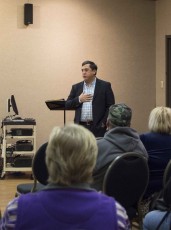By Karen Rios/ reporter
Music therapy helps to optimize the client’s health through music, a Texas Woman’s University assistant professor said Jan. 22 on NE Campus.

Karen Rios/The Collegian
Michael Zanders told music students about an alternative of therapy that uses music as an aid.
Music therapy has three major components: the therapist, the client and the music.
“Without the relationship between the therapist and client, it’s not therapy,” Zanders said. “The therapist learns from the client. The client learns from the therapist.”
This type of therapy is less of a hierarchy because the therapist acts as a guide for the client. Zanders said it’s a “humanist approach.”
“We are healthy when we are being creative,” he said. “Music is healthy.”
Those who don’t have a relationship with music can still do music therapy. Zanders doesn’t recommend this type of therapy for people who don’t wish to have that relationship or dislike music.
Interestingly, Zanders said, “Musicians are the worst clients.”
Zanders gave an example of how music therapy is used on clients, including one who had been physically and emotionally abused. The client acted out in school and stabbed a fellow student with a pencil but had no intention to kill. The client was young, so he had no coping skills.
To begin therapy, clients might be asked to bring in a song that explains or expresses their feelings, Zanders said. The therapist and client then look into lyrics and beats to better determine the mood of the client. Another method is to allow clients to choose an instrument and play what they feel. When they play the instrument, they express themselves through music.
Zanders believes music is more expressive than words. When someone asks, “How are you,” the usual response is “good,” even if it’s really not good. With music, it’s hard to hide that emotion, he said.
“You can tell the problem through music,” Zanders said.
Zanders said music therapy can still be used on non-verbal children and adults, and often therapists use it with autism. He also said they could start at any age. Some even start when they are babies.





























